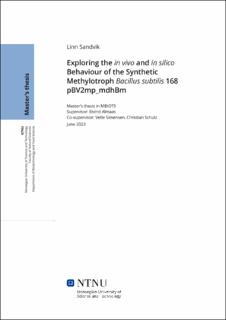| dc.contributor.advisor | Almaas, Eivind | |
| dc.contributor.advisor | Simensen, Vetle | |
| dc.contributor.advisor | Schulz, Christian | |
| dc.contributor.author | Linn Sandvik | |
| dc.date.accessioned | 2023-09-16T17:20:12Z | |
| dc.date.available | 2023-09-16T17:20:12Z | |
| dc.date.issued | 2023 | |
| dc.identifier | no.ntnu:inspera:138733117:25672535 | |
| dc.identifier.uri | https://hdl.handle.net/11250/3089908 | |
| dc.description.abstract | Bacillus subtilis er en type bakterie som er mye brukt som cellefabrikk i bioteknologisk industri (Su 2020). Bakterien kultiveres vanligvis med glukose som karbonkilde (Kleijn 2010), men det har oppstått en interesse for å finne alternative karbonkilder som ikke konkurrerer med matproduksjon. Et lovende alternativ er metanol som kan brukes som karbonkilde av såkalte metylotrofe mikroorganismer (Kleijn 2010). \emph{B. subtilis} er ikke en naturlig metylotrof, men det har blitt vist at syntetisk metylotrofi kan induseres i B. subtilis ved å få den til å uttrykke genet methanol dehydrogenase (Mdh). De syntetisk metylotrofe variantene av B. subtilis som har blitt fremstilt så langt, er imidlertid bare i stand til å bruke methanol som co-karbonkilde i tillegg til for eksempel glukose (Gao 2022). I vårt arbeid har vi utført eksperimentelle og in silico analyser for å bekrefte at B. subtilis faktisk er i stand til å bruke metanol som karbon kilde når Mdh er uttrykt. Dette ble gjort ved å utføre såkalte batch fermenteringer, hvor den muterte varianten B. subtilis 168 pBV2mp_mdhBm ble kultivert i minimalt medium som inneholdt glukose og metanol. Fenotypen til mutanten ble analysert eksperimentelt ved å måle biomassekomposisjon, aminosyrefordeling, vekstrate og opptaks- og sekresjonsrater av næringsstoffer og gasser. De eksperimentelle dataene ble også brukt til å oppdatere den nyeste tilgjengelige genomskala modellen (GEM) av B. subtilis, og den oppdaterte modellen ble brukt til å studere fenotypen til mutanten in silico. In silico analyser som ble utført er analyse av fluksbalanse (FBA) og fluksvariabilitetsanalyse (FVA). Disse analysene ble brukt for å undersøke distribusjonen av fluks gjennom det metabolske nettverket til mutanten. Resultatene fra eksperimentelle og in silico analyser stemmer overens med funnene som ble gjort av Gao et al. (Gao 2022), og viser at den muterte varianten er i stand til å bruke metanol som co-karbonkilde. Vi har også brukt resultatene våre for å foreslå videre analyser som kan utføres, for å føre oss nærmere en mutert variant av B. subtilis som kan bruke metanol som eneste karbonkilde. | |
| dc.description.abstract | Bacillus subtilis is a bacterial strain that is much used as a cell factory in biotechnological
industry [1]. It is typically cultivated with glucose as the carbon source [2], however it
has become of interest to find alternative carbon sources that do not compete with food
production. A promising alternative is methanol, which can be used as a carbon source
by so called methylotrophic microorganisms [3]. B. subtilis is not a natural methylotroph,
but it has been demonstrated that synthetic methylotrohpy can be induced in B. subtilis by
making it heterologously express a methanol dehydrogenase (Mdh) gene. However, the
synthetic methylotrophic B. subtilis strains that have been constructed so far are only able
to use methanol as a co-carbon source in addition to e.g. glucose [4]. In our work we have
conducted experimental and in silico analyses to confirm that B. subtilis is indeed able to
use methanol as a carbon source when Mdh is heterologously expressed. This was done
by conducting batch fermentations where an Mdh-expressing mutant strain, B. subtilis 168
pBV2mp mdhBm, was cultivated in minimal medium containing glucose and methanol.
The phenotype of the mutant was analyzed experimentally by measuring the biomass com-
position, amino acid distribution, growth rate, and uptake- and secretion rates of nutrients
and gas. The experimental data was also used to update the newest available genome-scale
metabolic model (GEM) of B. subtilis, which allowed us to study the phenotype of the mu-
tant in silico. The in silico analyses that were conducted were flux balance analysis (FBA)
and flux variability analysis (FVA), which were used to study the flux distribution through
the metabolic network of the mutant strain. The results from the experimental and in silico
analyses are in accordance with the findings of Gao et al. [4], and show that the mutant
strain can use methanol as a co-carbon source. Our results have also been used to propose
further analyses that can be conducted to bring us closer to a mutant B. subtilis strain that
can use methanol as the only carbon source. | |
| dc.language | eng | |
| dc.publisher | NTNU | |
| dc.title | Exploring the in vivo and in silico behaviour of the synthetic methylotroph Bacillus subtilis 168 pBV2mp_mdhBm | |
| dc.type | Master thesis | |
